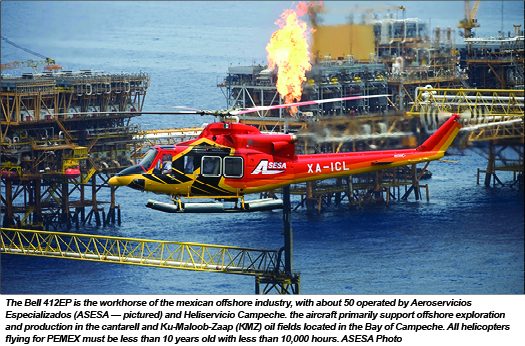
After 10 years of declining oil production, Mexico has initiated national energy reforms to stimulate offshore exploration in its deepwater regions and revive an industry that is among the country’s most crucial.
In 2013, the oil industry provided the Mexican government with almost one third of its revenues and 13 percent of
its exports. As such, correcting the 25 percent decline in production that has occurred since 2004 has become a significant priority.
The stated major objectives of the reforms being pushed forward by Mexican President Enrique Peña Nieto are to
end state-owned Petróleos Mexicanos’ (PEMEX’s) 75-year monopoly and attract foreign investment and technical expertise to find new oilfields.
This is potentially good news for Mexico’s offshore helicopter industry, which currently earns most of its living flying to the declining shallow-water oilfields in the Bay of Campeche in the southwestern part of the Gulf of Mexico that borders the states of Veracruz, Tabasco and Campeche. In total, the industry features some 60 helicopters that fly about two million passengers a year to oil and gas platforms off all of Mexico’s east coast.
Of course, flying further offshore will change the nature of helicopter operations in the region. New medium and super- medium helicopters, such as the Airbus Helicopters EC175, AgustaWestland AW189 and Bell 525 Relentless, will be favored, due to them having the payload and range required to reach most of the potential deepwater drilling sites in Mexican territorial waters.
While the entirety of the changes that will occur are still not fully known, a potential roadmap for Mexico’s industry can be found in what happened in Brazil, when the monopoly Petrobras had on the petroleum sector there ended almost two decades ago (see p.112, Vertical, Feb-Mar 2014).
Petróleos Mexicanos
State-owned PEMEX began offshore exploration in the late-1960s, and in 1976 discovered the supergiant Cantarell oilfield in the shallow water of the Bay of Campeche.
Cantarell and the adjacent Ku-Maloob-Zaap (KMZ) fields have long accounted for about three-quarters of Mexico’s offshore production, but their combined output has been declining rapidly since 2004 and these massive fields are
not easily replaced. This is in large part because Cantarell owes its origins to a unique extraterrestrial event — the impact of the Chicxulub asteroid on the Yucatán Peninsula about 65 million years ago (which also caused the mass extinction of the dinosaurs).
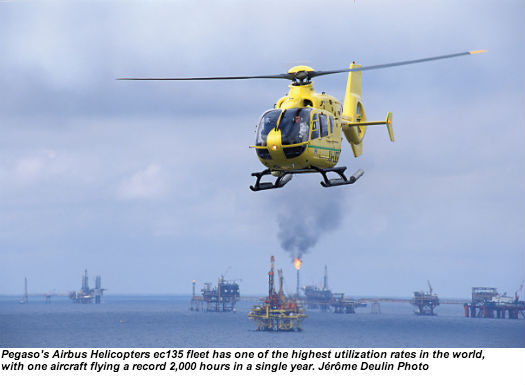
In some respects, Cantarell was so large and prolific for so long that there was no urgency to invest in deepwater exploration, unlike in the United States, where production from shallow-water oilfields in the Gulf of Mexico started to decline about 30 years ago. Cantarell, in fact, still accounted for 63 percent of Mexico’s total crude oil production in 2004, but that was down to only 17 percent in 2013.
Thankfully, KMZ’s production has been on the rise during that same period and has somewhat lessened, though not completely mitigated, the effects of Cantarell’s declining production.
Either way, even though they are no longer at their com- bined peak, these two oilfields continue to shape helicopter operations in the country.
The rise of the helicopter
Offshore helicopter operations in Mexico took off in the 1970s, when PEMEX created a helicopter division to fly its workforce offshore. The company’s offshore fleet peaked in 1991 at 30 helicopters — six Aérospatiale SA330J Pumas, 11 Sikorsky S-76s and 13 Bell 212s.
The fast-track development of Cantarell in the 1970s also provided work for three family owned helicopter companies: Aeroservicios Especializados S.A. de C.V. (Asesa), Heliservicio Campeche S.A. de C.V. and Transportes Aéreos Pegaso S.A. de C.V. Today, these “big three” rank in the top 25 of the world’s offshore helicopter operators by fleet size.

The offshore boom also transformed Ciudad del Carmen in the state of Campeche from a small, isolated, island fishing town, into the country’s main air logistics hub. The city is now home base for about 85 percent of the country’s entire offshore helicopter fleet.
The remaining offshore fleet supports regional activities
and shallow-water oil and gas fields from bases in the cities of Villahermosa and Dos Bocas in the southeastern state
of Tabasco; Veracruz and Poza Rica in the central-eastern state of Veracruz; and Tampico and Reynosa in the north- eastern state of Tamaulipas. Flights to deepwater drilling platforms, meanwhile, originate in the city of Veracruz or from Matamoros, Tamaulipas, which is right across the border from Brownsville, Texas.
The offshore workhorse
One of the unique things about offshore operations in Mexico is that one model currently lies at the heart of it all: the Bell 412.
When PEMEX closed its helicopter division in 1994, the aforementioned three commercial operators picked up the slack, using new Bell 412s to replace PEMEX’s Bell 212s and S-76s.
“Mexico is Bell Helicopter’s biggest offshore market in Latin America,” said Jay Ortiz, executive director, Latin America sales and marketing at Bell Helicopter Textron. “On a typical day you will see Bell 412EPs flying non-stop from Ciudad del Carmen airport carrying most of PEMEX’s offshore traffic.”
Even with deepwater missions set to change the landscape, Ortiz believes Bell will continue to be a force here: “The majority of PEMEX’s platforms are between 45 and 100 miles off the coast, which is a sweet spot for the Bell 412. We believe the 412 will continue to serve the majority of the oilfields, with the new Bell 525 [being] ideal for longer deep- water missions.”
The helicopters that fly PEMEX workers from Ciudad del Carmen to the oilfields also transfer up to 400 workers a day between the 27 large offshore production complexes, each with five or six heliports. These shuttle flights can generate five to nine landings an hour.
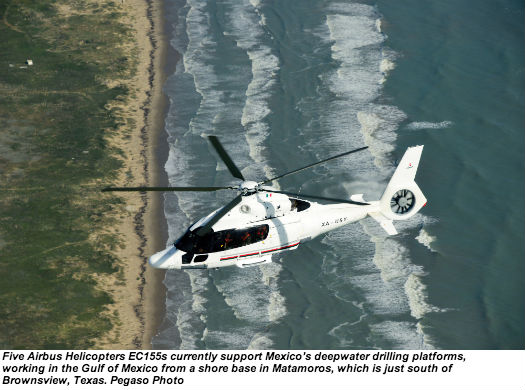
To support the large concentration of Bell 412s being used for offshore and government flights — Heliservicio Campeche and Asesa operate a total of 50 Bell 412EPs, with 30 on full-time contract to PEMEX — CAE positioned a Bell 412
full flight simulator at its new Mexican training center at the Toluca airport (Aeropuerto Internacional de Toluca), which is about 38 miles (61 kilometers) west of Mexico City.
That simulator is a particular boon because of the fleet usage rates and upgrade requirements here: in addition to PEMEX’s twin-engine-only stipulation, all helicopters must be less than 10 years old and have less than 10,000 hours total time. With an average utilization rate of 130 flight hours a month, Ortiz said that means most Bell 412EPs “time out” well before the end of their second five-year contract.
Heliservicio Campeche
Of the three main offshore operators in Mexico, Heliservicio Campeche (Campeche) probably has the greatest usage. PEMEX contracts 17 of Campeche’s 27 Bell 412EPs, with the total fleet averaging about 36,000 flight hours and more than 1.1 million passengers transported each year. (All 27 heli- copters are used in rotation due to high utilization rates and expected maintenance scheduling.) To date, the company has accumulated over a half-million flight hours since its founding. Founded in 1978, Heliservicio Campeche was purchased by Compañía Inversora Corporativa S.A de C.V. (CIC) in 1994 and was partially owned by the Bristow Group until 2010.
“CIC now owns 100 percent of the company,” said Alfredo Miguel Bejos, president of Heliservicio Campeche, “but we still have a close relationship with Bristow that includes leas- ing their aircraft and [sharing] safety management systems.”
This connection has resulted in Campeche leasing an S-76C++ from Bristow to support a seismic survey ship 120 miles offshore.
But, Campeche is still primarily a Bell operator: in 2013, it became the second company (just after Asesa) to introduce Bell 429s into the Mexican offshore market. (Both Campeche and Asesa will benefit from Mexico’s decision to approve the 500-pound increase for the 429, which gives the model a new maximum gross weight of 7,500 pounds.)
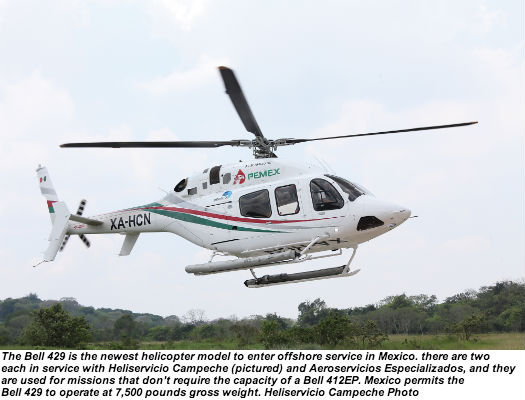
“The location of our offshore platforms is ideal for light-twin operations,” said Miguel Bejos. “We bought two Bell 429s
to replace [Airbus Helicopters] EC135s, and they are based
at Poza Rica in Veracruz state, where there is a lot of new offshore activity.”
Campeche’s fleet also includes four Bell 407s and a new Bell 407GX for onshore and non-PEMEX offshore customers (i.e., PEMEX sub-contractors). Miguel Bejos believes that under the new energy-sector reforms, PEMEX will continue to have a strong focus on shallow-water oil production.
Of course, that doesn’t mean he will let the com- pany neglect deepwater opportunities: “Our goal is to be ready to support deepwater exploration and [we] will lease helicopters as required.”
Plus, Campeche will also leverage its strengths and connections to Bell. This begins with the Bell 525 Relentless — an aircraft Miguel Bejos believes will have the performance demanded by the industry for deepwater operations — and is backed by both Campeche’s sister company, Servicio Técnico Aéreo de México, a Bell approved, platinum-level customer service facility and its parent company, CIC, an autho- rized Bell independent representative.
Aeroservicios Especializados
Mexico’s second-largest Bell 412EP customer is Aeroservicios Especializados (Asesa), a subsidiary of Grupo Lomex.
Founded by Humberto Lobo in 1977 as part of Grupo Protexa (and now controlled by Lobo’s son, Humberto Lobo de la Garza, through Grupo Lomex), Asesa’s first job was flying a single Bell 212 in support of PEMEX’s early offshore exploration efforts off Mexico’s Pacific coast. Some 37 years later, Asesa has accumulated more than 470,000 flight hours on a fleet that cur- rently includes 22 Bell 412EPs, two Bell 429s and five Bell 407s (two leased S-76C++s were returned to CHC in 2013).

As with Heliservicio Campeche, most of Asesa’s workload has traditionally centered on the Cantarell oilfield, and of course missions for PEMEX: its two new Bell 429s and 13 of its Bell 412s are currently on contract with PEMEX.
“At Cantarell, there are currently around 15,000 people sleeping every day at the platform area and this is expected to increase to 25,000 in 2015,” said Asesa commercial director Gabino Salazar, adding that the company flies some 600,000 people offshore each year.
New missions, however, are also on the horizon. Some are outside the oil industry — Asesa has
four Bell 407s flying for CFE (Comisión Federal de Electricidad), the state-owned electric company — but most lie in the planned production increases of existing oilfields and in deepwater expansion.
“There has been an increase in the exploration activities over the past four years as PEMEX moves from shallow to deep waters,” said Salazar. “They are under pressure from the government to maintain proven reserves and increase production from 2.5 million barrels per day to more than 3.0 million barrels per day.
“In 2012, there were around 56 drilling platforms and this is projected to increase to 110 by 2015 to maintain production levels.”
To handle deepwater missions, Asesa has taken a bold new direction: it is the first Mexican company to order the new-generation S-76D. Financing for its six S-76Ds was arranged by AirFinance Leasing and will come from Apple Bank, backed by a loan guarantee from the Export-Import Bank of the United States that is valued at more than $50 million US.
“We believe that the S-76D is suitable for both shallow- and deepwater operations, but expect ours will mostly be used for deepwater work,” remarked Salazar.
Still, Bell models remain Asesa’s main workhorses. Accordingly, the company operates a Bell customer service facility in Ciudad del Carmen to service its helicopters, including three 412EPs that sister com- pany Heliamérica SAC uses for onshore oil exploration in Peru.

Transportes Aéreos Pegaso
The smallest of Mexico’s big three offshore opera- tors also happens to be the only one touting the Airbus Helicopters lines.
Founded in 1981, Transportes Aéreos Pegaso (Pegaso) is Airbus Helicopters’ main offshore customer in Mexico.
Pegaso won its first offshore contract with PEMEX for four Aérospatiale AS350 B AStars back in 1983. When PEMEX moved to an “all twin-engine” policy in the 80s, Pegaso acquired the first of its MBB Bo.105 CBS models, on which it eventually put more than 50,000 flight hours. In 1993, Pegaso introduced its first BK-117s offshore and in 2004 its first EC145s.
“PEMEX used to provide helicopter flights for
its subcontractors,” said Enrique Zepeda Navarro, CEO of Pegaso, and son of the company’s founder, Enrique Zepeda Morales. “When they stopped including flights contracts, we were able to increase our market share by flying subcontractors such as Schlumberger, who didn’t require a Bell 412 to move only a few people.”
Still, Pegaso’s EC145s are no slouches when it comes to payload: they can carry up to 10 passengers each on short transfers.
In 2012, Pegaso took delivery of the milestone 500th and 501st EC145s ever produced. These were part of a larger order of EC145s made the previous year, some of which ended up being leased through Milestone Aviation.
“Today, we fly eight EC145s offshore and have another eight EC145s flying powerline patrols for CFE,” remarked Zepeda Navarro.
Pegaso averages about 42,000 offshore operations a year and transports some 200,000 passengers with an offshore fleet that also includes two EC130 B4s, three EC135s and four BK-117 C-1s.
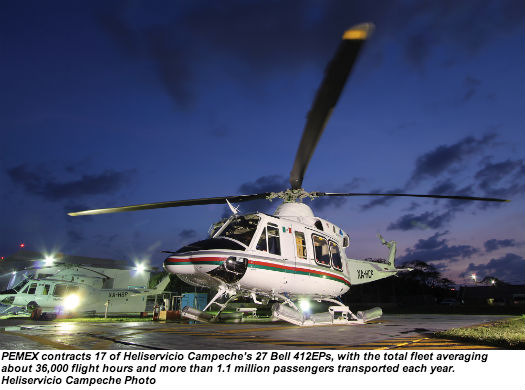
The company’s first three EC135 P1s were introduced in 2003 and 2004, and performed yeoman’s service: in 2012, Eurocopter recognized Pegaso for flying one of its P1s a total 2,000 flight hours off- shore in a single year. And, three new EC135s were recently ordered to replace three seven-year-old models that have already flown a combined total of 30,000 hours offshore.
To handle the burgeoning deepwater drilling work, Pegaso has been moving up the Airbus Helicopters line.
Said Zepeda Navarro: “We started with two Eurocopter EC155 B1s in 2011 . . . and now operate five [EC155s] from Matamoros in support of three drilling platforms drilling
in deepwater about 140 nautical miles offshore, south of [Shell’s] Perdido well.”
Pegaso is also slated to be a launch customer for the upcom- ing EC175. Said Zepeda Navarro: “We converted our options into a firm order for two Airbus EC175s for delivery [for] 2016 deepwater work. We expect deepwater work to increase and the oil companies also want a larger helicopter available for rig evacuations.”
That ability to evacuate is particularly important, since Mexican offshore oilfields, just like their American Gulf Coast counterparts, frequently encounter hurricanes.

The other players
While the big three carry most of PEMEX’s traffic, two smaller operators also have bases at Ciudad del Carmen to fly PEMEX’s independent contractors, who don’t require the payload capacity of an EC145 or Bell 412.
One of those two, Apoyo Logístico Aéreo (ALA), has made more than 6,500 offshore flights since 2009, transporting around 56,000 people to PEMEX platforms with its three EC135s. ALA also specializes in offshore medical transport, flying patients from PEMEX oil platforms in the Bay of Campeche area and from Ciudad del Carmen, to hospitals in nearby cities.
The other small operator is Heliamérica México S.A. de C.V., which flies an offshore fleet of EC130 B4s (plus a small collection of AS350s for VIP, air ambulance, film, and search and rescue work).
And, finally, there is also Grupo R, which owns the
three new deepwater platforms drilling off the coast of northeastern Mexico, and utilizes a corporate AW139 based in Matamoros to support its multi-million-dollar offshore investments.
It may be this last company that is the best indicator of the changes and promise that could lie ahead for Mexico.
“The future looks very promising if the oil industry reforms take place,” said Pegaso CEO Zepeda Navarro. “We don’t know all the details, but if they let American and European
oil companies explore, we will see a steady increase in deep- water drilling. . . . PEMEX hasn’t had the capital to invest in exploration, which is why we need to attract foreign capital to increase exploration.”
While foreign capital could also mean foreign helicopter operators, the hope is for something similar to what happened when Brazil opened its markets: international investors and operators partnered with local helicopter companies to help them upgrade their fleets, technical expertise and safety culture. It was a boom shared by both sides.





